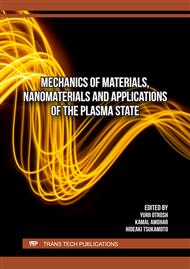[1]
Yu. Otrosh, O. Semkiv, E. Rybka, A. Kovalov, About need of calculations for the steel framework building in temperature influences conditions. IOP Conference Series: Materials Science and Engineering. 708(1) (2019) 012065
DOI: 10.1088/1757-899X/708/1/012065
Google Scholar
[2]
A. Kovalov, Y. Otrosh, O. Ostroverkh, O. Hrushovinchuk, O. Savchenko, Fire resistance evaluation of reinforced concrete floors with fire-retardant coating by calculation and experimental method. E3S Web of Conferences. 60 (2018) 00003
DOI: 10.1051/e3sconf/20186000003
Google Scholar
[3]
V. Sadkovyi, V. Andronov, O. Semkiv, A. Kovalov, E. Rybka, Y. Otrosh, M. Udianskyi, V. Koloskov, A. Danilin, P. Kovalov, Fire resistance of reinforced concrete and steel structures. (2021) 1–166
DOI: 10.15587/978-617-7319-43-5
Google Scholar
[4]
A. Kovalov, Y. Otrosh, S. Vedula, O. Danilin, T. Kovalevska, Parameters of fire-retardant coatings of steel constructions under the influence of climatic factors. Naukovyi Visnyk Natsionalnoho Hirnychoho Universytetu. 3 (2019) 46–53
DOI: 10.29202/nvngu/2019-3/9
Google Scholar
[5]
Yu. Otrosh, M. Surianinov, O. Holodnov, O. Starova, Experimental and computer researches of ferroconcrete beams at high-temperature influences. Materials Science Forum. 968 (2019). 355–360
DOI: 10.4028/www.scientific.net/MSF.968.355
Google Scholar
[6]
J. Cai, J. Wang, Q. Zhang, C. Du, M. Meloni, J. Feng, State-of-the-art of mechanical properties of 3D printed concrete. Case Studies in Construction Materials. 21 (2024) e03847.
DOI: 10.1016/j.cscm.2024.e03847
Google Scholar
[7]
C. Liu, S. Yue, C. Zhou, H. Sun, S. Deng, F. Gao, Y. Tan, Anisotropic mechanical properties of extrusion-based 3D printed layered concrete. Journal of Materials Science. 56(30) (2021) 16851–16864.
DOI: 10.1007/s10853-021-06416-w
Google Scholar
[8]
A. Kantaros, F.I.T. Petrescu, K. Brachos, T. Ganetsos, N. Petrescu, Leveraging 3D printing for resilient disaster management in smart cities. Smart Cities. 7(6) (2024) 3705–3726.
DOI: 10.3390/smartcities7060143
Google Scholar
[9]
O. Mohamed, A. Mishra, F. Isam, An overview of 3D printed concrete for building structures: Material properties, sustainability, future opportunities, and challenges. In Structures. 78 (2025) 109284.
DOI: 10.1016/j.istruc.2025.109284
Google Scholar
[10]
G., Girskas, M. Kligys, 3D Concrete Printing Review: Equipment, Materials, Mix Design, and Properties. Buildings. 15(12) (2025) 2049.
DOI: 10.3390/buildings15122049
Google Scholar
[11]
F.Y. Li, X. Hu, Q. Shahzad, Anisotropic Behavior in 3D Printed Concrete: Finite Element Simulation Approach. Journal of Materials Engineering and Performance. (2024) 1–12.
DOI: 10.1007/s11665-024-10536-0
Google Scholar
[12]
J.P. Mostert, J. Kruger, Reducing anisotropic behaviour of 3D printed concrete through interlocked filaments. Materials and Structures. 58(5) (2025) 192.
DOI: 10.1617/s11527-025-02723-9
Google Scholar
[13]
G. Duarte, J.P. Duarte, N. Brown, A. Memari, J.P. Gevaudan, Design for early-age structural performance of 3D printed concrete structures: A parametric numerical modeling approach. Journal of Building Engineering. 94 (2024) 109986.
DOI: 10.1016/j.jobe.2024.109986
Google Scholar
[14]
B. Nan, Y. Qiao, J. Leng, Y. Bai, Advancing Structural Reinforcement in 3D-Printed Concrete: Current Methods, Challenges, and Innovations. Materials. 18(2) (2025) 252.
DOI: 10.3390/ma18020252
Google Scholar
[15]
K. Momeni, N.I. Vatin, M. Hematibahar, T.H. Gebre, Differences between 3D printed concrete and 3D printing reinforced concrete technologies: A review. Frontiers in Built Environment. 10 (2025) 1450628.
DOI: 10.3389/fbuil.2024.1450628
Google Scholar
[16]
M. Surianinov, V. Andronov, Y. Otrosh, T. Makovkina, S. Vasiukov, Concrete and fiber concrete impact strength (2020) Materials Science Forum. 1006 (2020) 101. DOI: 10.4028%2fwww.scientific.net%2fMSF.1006.101&par106.
DOI: 10.4028/www.scientific.net/msf.1006.101
Google Scholar
[17]
D. Sokolov, V. Sobyna, S. Vambol, V. Vambol, Substantiation of the choice of the cutter material and method of its hardening, working under the action of friction and cyclic loading. Archives of Materials Science and Engineering. 94/2 (2018) 49–54.
DOI: 10.5604/01.3001.0012.8658
Google Scholar
[18]
A. Kovalov, R. Purdenko, Yu. Otrosh, V. Tоmеnkо, N. Rashkevich, E.Shcholokov, M. Pidhornyy, N. Zolotova, O. Suprun, Assessment of fire resistance of fireproof reinforced concrete structures. Eastern-European Journal of Enterprise Technologies. 5/1 (119) (2022) 53–61.
DOI: 10.15587/1729-4061.2022.266219
Google Scholar
[19]
I. Medved, N. Rashkevich, Yu. Otrosh, V. Tomenko, Analysis of Experimental Studies of Titanium Alloy. Materials Science Forum. 1141 (2024) 35–42.
DOI: 10.4028/p-rYw4RJ
Google Scholar
[20]
N. Rashkevich, R. Shevchenko, S. Yeremenko, Development of an Organizational and Technical Method of Emergency Prevention of Technological Character Оn the Territory Which Was Attacked by Rocket and Artillery Impacts. In: Babak, V., Zaporozhets, A. (eds) Systems, Decision and Control in Energy VII. Studies in Systems, Decision and Control. 595 (2025) 717–747.
DOI: 10.1007/978-3-031-90466-0_33
Google Scholar
[21]
K. Momeni, N.I. Vatin, M. Hematibahar, T.H. Gebre, Differences between 3D printed concrete and 3D printing reinforced concrete technologies: A review. Frontiers in Built Environment.10 (2025) 1450628.
DOI: 10.3389/fbuil.2024.1450628
Google Scholar
[22]
M.V. Savytski, A.Y. Konoplyanyk, A.O. Myslytska, A.V. Liasota, Determination of physico-mechanical characteristics of concrete for 3D printing building designs. Bulletin of the Dnieper State Academy of Civil Engineering and Architecture. 2 (2020) 263–264.
DOI: 10.30838/j.bpsacea.2312.280420.64.622
Google Scholar
[23]
DBN V.2.6-162:2010 Constructions of buildings and structures. Stone and reinforced stone structures. Basic provisions. With Amendment No. 1. https://online.budstandart.com/ua/catalog/doc-page.html?id_doc=26738
Google Scholar
[24]
DBN V.2.6-98:2009 Structures of buildings and structures. Concrete and reinforced concrete structures. Basic provisions. With Amendment No. 1. https://online.budstandart.com/ua/catalog/doc-page.html?id_doc=26677
Google Scholar


